Nature Awakes |
||||||||||||||||||||||||||||||||||||||||
 |
 |
|||||||||||||||||||||||||||||||||||||||
Knitted jumper with round yoke in DROPS Alpaca and DROPS Delight. The piece is worked top down with 2-coloured English rib, stripes and lace pattern. Sizes S - XXXL.
DROPS 213-5 |
||||||||||||||||||||||||||||||||||||||||
|
------------------------------------------------------- EXPLANATIONS FOR THE PATTERN: ------------------------------------------------------- RIDGE/GARTER STITCH (worked in the round): 1 ridge in height = 2 rounds; Knit 1 round and purl 1 round. PATTERN: See diagrams A.1 to A.7. A.2 is the lace pattern. A.1 and A.3 to A.7 are English rib using off-white and blueberry pie. INCREASE TIP-1 (evenly spaced): To work out how to increase evenly, count the total number of stitches on the needle (e.g. 123 stitches) and divide by the number of increases to be made (e.g. 42) = 2.9. In this example, increase by making 1 yarn over after approx. each 3rd stitch. On the next round work the yarn overs twisted to avoid holes. INCREASE TIP-2 (for sides of body): Work until there are 2 stitches left before the marker thread, make 1 yarn over, knit 4 (marker thread sits between these 4 stitches) make 1 yarn over. On the next round work the yarn overs twisted to avoid holes. Then work the new stitches in stocking stitch. 2-COLOURED ENGLISH RIB: Work in stripes. The unfilled and filled squares (outside the diagrams) show which colour to use on the round. DECREASE TIP (for sleeves): Decrease 1 stitch on each side of the marker thread as follows: Work until there are 3 stitches left before the marker thread, knit 2 together, knit 2 (marker thread sits between these 2 stitches), slip 1 stitch as if to knit, knit 1 and pass the slipped stitch over the knitted stitch. CASTING-OFF TIP: To avoid the cast-off edge being tight you can cast off with a larger size needle. If the edge is still tight, make 1 yarn over after approx. each 4th stitch at the same time as casting off and the yarn overs are cast off as normal stitches. ------------------------------------------------------ START THE PIECE HERE: ------------------------------------------------------- JUMPER – SHORT OVERVIEW OF THE PIECE: The neck and yoke are worked in the round with circular needle, top down from mid back. The yoke is divided for body and sleeves and the body continued in the round with circular needle. The sleeves are worked in the round with double pointed needles, top down. NECK: Cast on 117-123-129-132-141-144 stitches with circular needle size 2.5 mm and off-white. Knit 1 round, then work rib in the round (= knit 1 / purl 2). When the piece measures 2 cm, knit 1 round and increase 40-42-44-46-46-52 stitches evenly spaced – read INCREASE TIP-1 = 157-165-173-178-187-196 stitches. Change to circular needle size 3 mm. Insert 1 marker at the beginning of the round, mid back; the yoke will be measured from here! YOKE: Work stocking stitch in the round until the piece measures 2-3-3-3-4-4 cm from the marker Change to camel. Knit 3 rounds. Knit 1 round and increase 41-43-45-46-47-52 stitches evenly spaced = 198-208-218-224-234-248 stitches. Purl 1 round. Change to off-white. Knit 1 round. ENGLISH RIB: Change to circular needle size 2.5 mm. Continue with pattern and blueberry pie and off-white as follows – read 2-COLOURED ENGLISH RIB: Work A.1 (= 2 stitches) over all stitches. Repeat A.1a in height until the piece measures 7-8-9-9-10-10 cm from the marker (i.e. approx. 4-4-5-5-5-5 cm English rib), adjust so you finish with a round off-white. Change to circular needle size 3 mm and continue with off-white as follows: LACE PATTERN: Knit 2 rounds (the yarn overs from the English rib are knitted together with their respective stitches on the first round). Change to camel. Work 1 RIDGE – read description above and increase 22-24-28-34-38-44 stitches evenly on the first round = 220-232-246-258-272-292 stitches. On the next round work as follows: Work A.2 (= 2 stitches) over all stitches. Change to off-white. Knit 1 round and increase 52-56-58-62-64-76 stitches evenly spaced = 272-288-304-320-336-368 stitches. ENGLISH RIB: Change to blueberry pie. Knit 1 round. Change to circular needle size 2.5 mm. Work A.3 over all stitches. When A.3 has been worked 1 time in height continue with pattern as follows: Work * A.4 (= 3 stitches), A.5 (= 9 stitches), A.4 over 3 stitches, A.6 (= 1 stitch) *, work from *-* a total of 17-18-19-20-21-23 times in width. Repeat A.4 to A.6 until the piece measures approx. 20-21-22-25-26-28 cm; adjust so you finish after a whole or half repeat in height. Change to circular needle size 3 mm. Knit 1 round with blueberry pie and increase 47-67-70-80-88-92 stitches evenly spaced (the yarn overs from the English rib are knitted together with their stitches) = 319-355-374-400-424-460 stitches. Change to off-white. Knit 1 round and increase 0-0-15-29-45-45 stitches evenly spaced = 319-355-389-429-469-505 stitches. Work stocking stitch until the piece measures 20-22-23-26-27-29 cm from the marker. Now divide the piece for body and sleeves: Work 46-52-55-61-68-75 stitches (= half back piece), place the next 68-74-84-92-98-102 stitches on a thread for sleeve and cast on 8 stitches under the sleeve, work 91-103-111-123-137-151 stitches (= front piece), place the next 68-74-84-92-98-102 stitches on a thread for sleeve and cast on 8 stitches under the sleeve and finish by working 46-52-55-61-68-75 stitches (= half back piece). BODY: = 199-223-237-261-289-317 stitches. Knit 1 round and decrease 17-21-21-23-25-27 stitches evenly spaced = 182-202-216-238-264-290 stitches. Knit 1 round. ENGLISH RIB: Change to circular needle size 2.5 mm. Work A.1. Repeat A.1a in height until the English rib measures approx. 3 cm. Change to circular needle size 3 mm. REST OF BODY: Now finish the piece using off-white and stocking stitch. On the next round increase 17-21-21-23-25-27 stitches evenly spaced (the yarn overs from the English rib are knitted together with their respective stitches) = 199-223-237-261-289-317 stitches. Insert 1 marker thread 50-56-59-65-72-79 stitches in from each end of the round (= in sides of body). There are 99-111-119-131-145-159 stitches between the markers on the front piece; allow the threads to follow your work onwards, they will be used when increasing in the sides. When the piece measures 2 cm from the English rib, increase 1 stitch on each side of both marker threads – read INCREASE TIP-2 (= 4 stitches increased). Increase like this every 2½ cm a total of 8-6-7-7-7-8 times = 231-247-265-289-317-349 stitches. When the piece measures 29-29-30-29-30-30 cm from the division increase 57-59-59-59-58-59 stitches evenly spaced = 288-306-324-348-375-408 stitches. Change to circular needle size 2.5 mm and work rib (= knit 1/ purl 2) for 4 cm, then cast off with knit – read CASTING-OFF TIP! SLEEVES: Place the 68-74-84-92-98-102 stitches from the thread on the one side of the piece on double pointed needles size 3 mm and knit up 1 stitch in each of the 8 stitches cast on under the sleeve = 76-82-92-100-106-110 stitches. Insert a marker thread in the middle of the 8 stitches under the sleeve. Allow the thread to follow your work onwards; it will be used when decreasing under the sleeve. Knit 2 rounds with off-white. On the next round decrease 8 stitches evenly spaced = 68-74-84-92-98-102 stitches. Then work pattern as follows: ENGLISH RIB: Change to double pointed needles size 2.5 mm. Continue pattern with blueberry pie and off white as follows: Work A.7 (= 2 stitches) in the round over all stitches. On the first 12 rounds use blueberry pie for the knitted stitches, on the last 4 rounds use off-white – see markers in diagram A.7. REST OF SLEEVE: Change to double pointed needles size 3 mm. Finish the sleeve with off-white. Work stocking stitch (the yarn overs from the English rib are knitted together with their respective stitches on the first round). On the first round increase 8 stitches evenly spaced = 76-82-92-100-106-110 stitches. On the next round decrease 1 stitch on each side of the marker thread – read DECREASE TIP (= 2 stitches decreased). Decrease like this every 2½-2-1½-1-1-1 cm a total of 12-14-17-20-22-23 times = 52-54-58-60-62-64 stitches. When the piece measures 38-37-36-34-33-32 cm from the division increase 11-12-11-12-10-11 stitches evenly spaced = 63-66-69-72-72-75 stitches. Change to double pointed needles size 2.5 mm and work rib (= knit 1/ purl 2) for 4 cm, then cast off with knit. Work the other sleeve in the same way. |
||||||||||||||||||||||||||||||||||||||||
Diagram explanations |
||||||||||||||||||||||||||||||||||||||||
|
||||||||||||||||||||||||||||||||||||||||

|
||||||||||||||||||||||||||||||||||||||||

|
||||||||||||||||||||||||||||||||||||||||
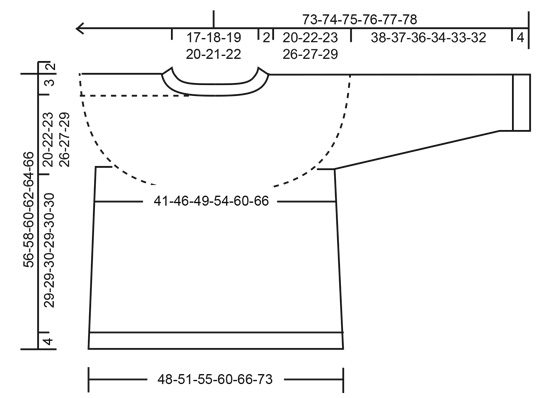
|
||||||||||||||||||||||||||||||||||||||||
|
Have you made this or any other of our designs? Tag your pictures in social media with #dropsdesign so we can see them! Do you need help with this pattern?You'll find tutorial videos, a Comments/Questions area and more by visiting the pattern on garnstudio.com. © 1982-2024 DROPS Design A/S. We reserve all rights. This document, including all its sub-sections, has copyrights. Read more about what you can do with our patterns at the bottom of each pattern on our site. |
||||||||||||||||||||||||||||||||||||||||








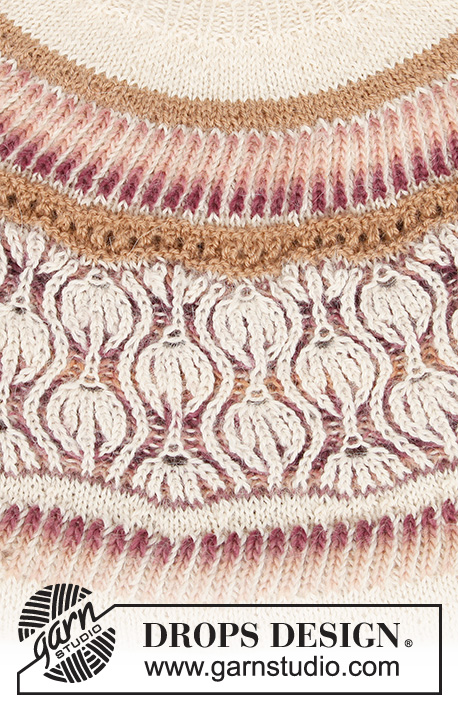
























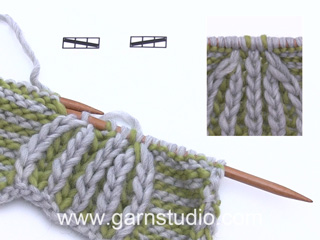

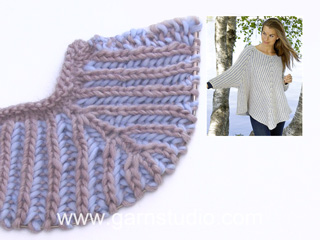














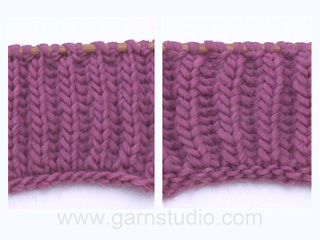





























Comments / Questions (54)
Love this! Can't wait to see the pattern
23.01.2020 - 14:46Magical !!! Knitted brioche, very interestingly designed. I firmly believe, I hope that it will be translated into the Czech language, the saddle will be quite demanding for accuracy ....
22.01.2020 - 18:58Nádherný model, pevně věřím, že uspěje. Modlím se, aby byl přeložen do českého jazyka. Je tam poměrně složitý vzor, něžná krása.....
22.01.2020 - 18:41Kjempefin modell. Gleder meg til å strikke denne !
21.01.2020 - 23:43Il est magnifique j’espère qu’il fera partie de la nouvelle collection.
19.01.2020 - 10:08Me encanta este es mio
18.01.2020 - 11:26Wouw, das ist Mal ein tolles Muster
15.01.2020 - 22:02Så smuk. Den vil jeg gerne strikke.
15.01.2020 - 13:07Stupendo!me ne sono innamorata.....
12.01.2020 - 23:35Tres beau design et couleur j'adore
09.01.2020 - 16:57